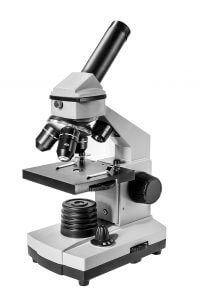Posted on: Wednesday, September 28th, 2022 In: Blog, Learning Optics with Austin
Microscope objective lenses are a classic example of optics in our lives. The function of the microscope is to enlarge objects our eyes cannot see. Unlike telescopes which enlarge far away objects, the sample observed by the microscope is close to the lens. Microscopes also correct aberration, which otherwise would lead to blurry images. Achromatic (doublet) lenses only correct for aberration of two wavelengths of light whereas apochromatic (triplet) lenses correct for 3 or more wavelengths.

One of the factors that go into designing an objective lens is the magnification. The colored bands on the outside of the microscope indicate the magnification of the lens. The standard magnification bands are as follows: red band = 5x, yellow = 10x, green = 20x, blue = 40-60x, white = 100x. Thus, if a lens has a green and yellow band, the magnification would be 30x.

Another factor to consider in designing an objective lens is the working distance (WD). This is defined to be the distance from the front of the objective to the sample when in sharp focus. Working distance is related to the numerical aperture (NA) which is calculated by the formula NA = n * sin(θa), where n is the index of refraction. When in air, n = 1. To obtain a greater refractive index and increase the numerical aperture, sometimes the objective is immersed in a liquid such as oil or water. While aberration, magnification, working distance, and numerical aperture are not the only variables to consider when designing a microscope, they are key characteristics that one should look for.
